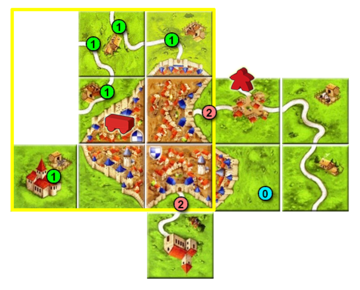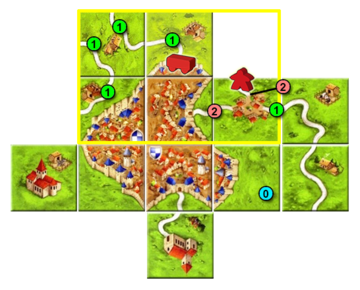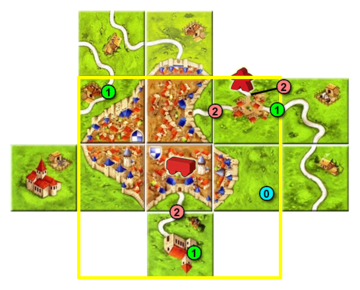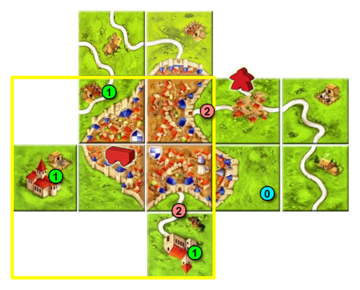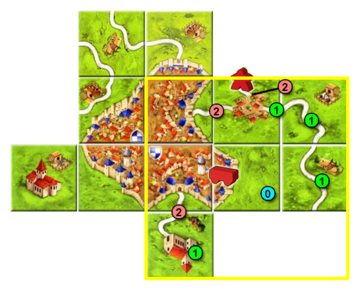Difference between revisions of "Wagon Movement Rules Changes/cs"
(Created page with "Město je dokončené (obestavěné hradbami). K městu přiléhá několik luk a 3 cesty. Dvě cesty jsou dokončené, vůz se tedy může přesunout pouze na nedokončenou cestu v horní části.") |
(Created page with "Kartička, na které je vůz ve městě umístěn, nemá vliv na možné varianty. Výsledek je vždy stejný: sousední nedokončené a neobsazené území.") |
||
| Line 61: | Line 61: | ||
Město je dokončené (obestavěné hradbami). K městu přiléhá několik luk a 3 cesty. Dvě cesty jsou dokončené, vůz se tedy může přesunout pouze na nedokončenou cestu v horní části. | Město je dokončené (obestavěné hradbami). K městu přiléhá několik luk a 3 cesty. Dvě cesty jsou dokončené, vůz se tedy může přesunout pouze na nedokončenou cestu v horní části. | ||
Kartička, na které je vůz ve městě umístěn, nemá vliv na možné varianty. Výsledek je vždy stejný: sousední nedokončené a neobsazené území. | |||
Stejně tak, pokud je vůz přesunut na nedokončenou cestu, může být umístěn na kteroukoli z jejich kartiček. | |||
[[File:Abbey_And_Mayor_C1_Wagon_Additional_Example_02.png|frame|none|'''Example C1-2.''' | [[File:Abbey_And_Mayor_C1_Wagon_Additional_Example_02.png|frame|none|'''Example C1-2.''' | ||
Revision as of 12:08, 28 August 2022
Úvod
Pravidla pro pohyb vozu se mezi jednotlivými vydáními změnila. Tyto změny mají vliv na způsob pohybu vozu po získání bodů a jeho akční rádius.
Pravidla pro jednotlivé edice jsou k dispozici zde:
- První edice: Pravidla pro vůz v první edici
- Druhá edice: Pravidla pro vůz v druhé edici
Následující části ilustrují tyto rozdíly na různých příkladech. [1]
Původní vydání
Pokud je vůz umístěn v dokončeném a hodnoceném městě, může se přesunout na cestu pouze tehdy, pokud tato cesta (nedokončená a neobsazená) přímo sousedí s tímto městem (spojená s městskými hradbami, branou). Protože louka je také území, nesmí být mezi cestou a městem žádné louka. Nezáleží na tom, kde je vůz umístěn v rámci dokončeného a hodnoceného území (např. města) před jeho přesunem. Za platný cíl pro vůz lze považovat i části krajiny, které mají jednu plochu, např. přilehlé opatství nebo klášter ve městě.
Pohyb vozu závisí výhradně na sousedství dvou území, nikoli na počáteční poloze vozu v rámci dokončeného a hodnoceného území. Stejně tak se vůz může přesunout na libovolnou část přilehlého území (počet kartiček, o které se vůz přesune, nehraje roli).
Příklad 1. Přesun z dokončeného města
Po dokončení a vyhodnocení města se vůz přesune na sousední území, který musí být nedokončené a neobsazené.
Město doplňují okolní hradby a opatství. K městu přiléhá několik luk, nedokončená cesta, krátká cesta a nedokončené opatství. Kromě toho se na území města nachází také nedokončený klášter.
Vůz se může přesunout na:
- Nedokončenou cestu (kteroukoli z jejích kartiček)
- Nedokončené opatství
- Nedokončený klášter uvnitř města
Vůz se nemůže přesunout na:
- jakoukoli louku sousedící s městem
- jakoukoli cestu, která není spojena s městem branou
- krátkou cestu spojenou s městem a jakákoli cestu s ní spojenou přes křižovatku.
- Nedokončená cesta spojená s opatstvím, protože není přímo spojena s městem.
- Klášter s dokončenou cestou napojenou na opatství
- Nedokončené město spojené krátkou cestou a křižovatkou
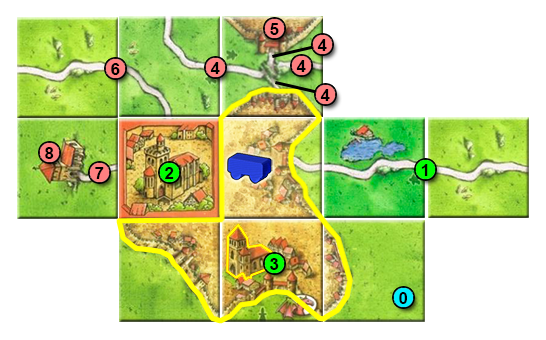
- 0 Právě přiložená kartička.
- 1 Vůz se může přesunout na tuto cestu.
- 2 Vůz se může přesunout do tohoto opatství.
- 3 Vůz se může přesunout do kláštera uvnitř města.
- 4 Vůz se nemůže přesunout na krátkou cestu končící v dokončeném městě, ani na žádnou cestu, která je k této cestě připojena přes křižovatku.
- 5 Vůz se na toto město nemůže přesunout, protože je s dokončeným městem spojeno krátkou cestou a křižovatkou.
- 6 Na tuto nedokončenou cestu se vůz nemůže přesunout, protože je spojena s opatstvím, nikoli s dokončeným městem.
- 7 Na tuto nedokončenou cestu se vůz nemůže přesunout, protože je dokončena a spojena s opatstvím, nikoliv s dokončeným městem.
- 8 Na tento klášter se vůz nemůže přesunout, protože není přímo spojen s dokončeným městem; je spojen s dokončenou cestou vedoucí ke klášteru.
Příklad 2. Přesun z dokončeného města
Po dokončení a vyhodnocení města se vůz přesune na sousední území, který musí být nedokončené a neobsazené.
Město je dokončené (obestavěné hradbami). K městu přiléhá několik luk a 3 cesty. Dvě cesty jsou dokončené, vůz se tedy může přesunout pouze na nedokončenou cestu v horní části.
Kartička, na které je vůz ve městě umístěn, nemá vliv na možné varianty. Výsledek je vždy stejný: sousední nedokončené a neobsazené území.
Stejně tak, pokud je vůz přesunut na nedokončenou cestu, může být umístěn na kteroukoli z jejich kartiček.
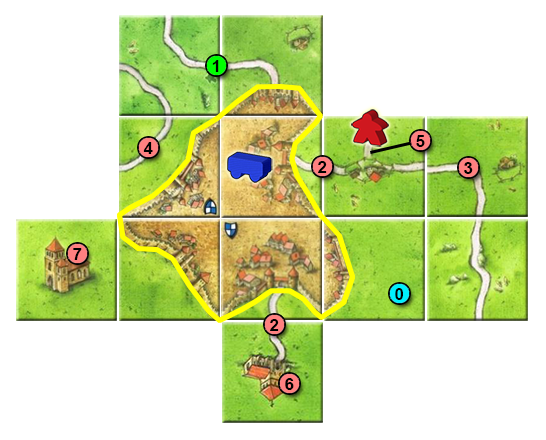
- 0 Tile just placed.
- 1 The wagon can move to this road. It can be placed on any of its tiles.
- 2 These roads are connected to the city but they are completed.
- 3 This road does not border directly at the city wall because it starts at the junction.
- 4 This road does not border directly at the city wall because there is a field (farm) between this road and the completed city.
- 5 This road does not border directly at the city wall because it starts at the junction and it is occupied.
- 6 This monastery (cloister) is not directly adjacent to the completed city because there is a completed road between the monastery (cloister) and the completed city.
- 7 This monastery (cloister) is not directly adjacent to the completed city because it is surrounded by a field (farm).
Example 3. Moving from a completed road
After the road is completed and scored, the wagon moves to an adjacent feature which has to be incomplete and unoccupied.
The wagon can move to an adjacent feature on any of the road's ends. The number of tiles the wagon moves is irrelevant. It is only important that the feature is directly adjacent to the completed road.
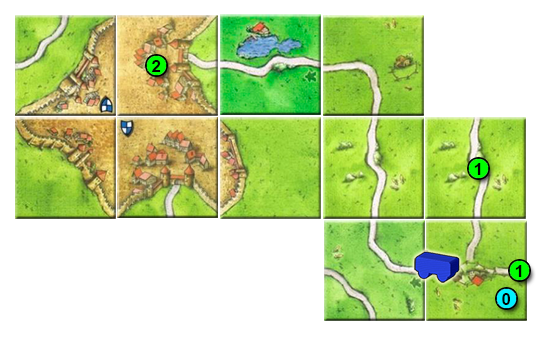
- 0 Tile just placed.
- 1 The wagon can move to any tile of these directly adjacent roads, because they are uncompleted and unoccupied.
- 2 The wagon can move to any of the tiles in the city because it is directly adjacent to the completed road (the city closes its left end), and it is uncompleted and unoccupied.
New edition
The wagon can move to any feature except fields. However, the new edition allows the wagon to cross a field to reach an uncompleted unoccupied feature on the same tile where the wagon is placed or on an adjacent tile.
Moving the wagon depends on the location of the wagon within the feature completed and scored. The target feature can be on the same tile or on an adjacent one. Therefore, the wagon can move one tile away at most.
Example 1. Moving from a completed city
After the city is completed and scored, the wagon moves to an adjacent feature which has to be incomplete and unoccupied.
In this case, "adjacent" means a feature on the same tile as the wagon or on a tile orthogonally or diagonally adjacent to it.
This means, the wagon action range is limited because it can only move to the same tile or to any of the tiles on the 8 spaces surrounding it.
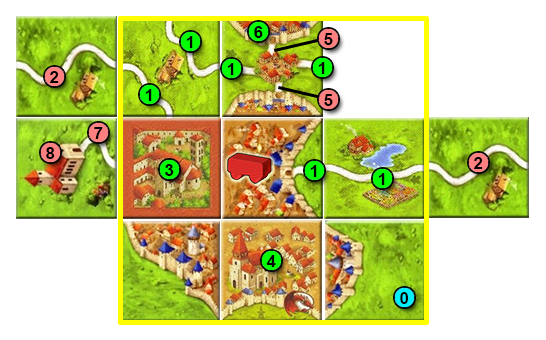
- 0 Tile just placed.
- 1 The wagon can move to any of these road segments on tiles within range because they belong to uncompleted unoccupied features.
- 2 The wagon cannot move to these road segments on tiles out of range even if they belong to uncompleted unoccupied features.
- 3 The wagon can move to this uncompleted unoccupied abbey because it is within range.
- 4 The wagon can move to the uncompleted unoccupied monastery within the city because it is within range.
- 5 The wagon cannot move to any of these short roads.
- 6 The wagon can move to this uncompleted unoccupied city segment within range.
- 7 The wagon cannot move to this road because it is completed and out of range.
- 8 The wagon cannot move to this monastery because it is out of range even if it is uncompleted and unoccupied.
Example 2. Moving from a completed city
After the city is completed and scored, the wagon moves to an adjacent feature which has to be incomplete and unoccupied.
In this case, "adjacent" means a feature on the same tile as the wagon or on a tile orthogonally or diagonally adjacent to it.
This means, the wagon action range is limited because it can only move to the same tile or to any of the tiles on the 8 spaces surrounding it.
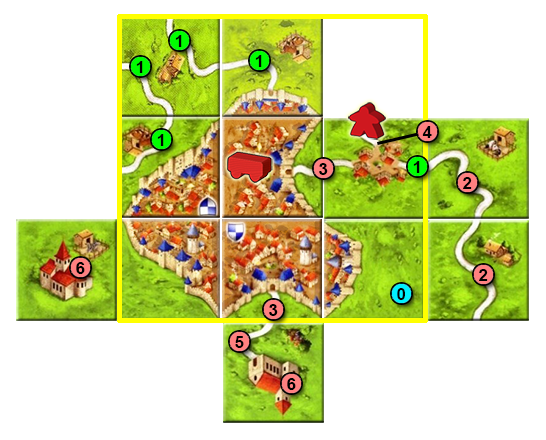
- 0 Tile just placed.
- 1 The wagon can move to any of these road segments on tiles within range because they belong to uncompleted unoccupied roads.
- 2 The wagon cannot move to these road segments on tiles out of range even if they belong to uncompleted unoccupied roads.
- 3 The wagon cannot move to this road segment on a tile within range because the feature is completed.
- 4 The wagon cannot move to this road segment on a tile within range because the feature is uncompleted but occupied.
- 5 The wagon cannot move to this road segment because it is out of range and belongs to a completed feature.
- 6 The wagon cannot move to any of these monasteries because they are out of range although uncompleted and unoccupied.
Depending on the position of the wagon in the city, the action range changes, as shown below.
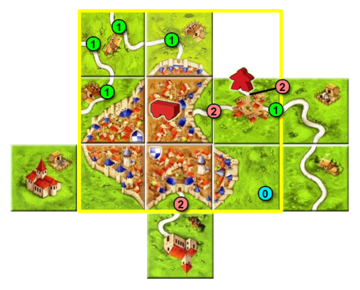
- 0 Tile just placed.
- 1 The wagon can move to any of these road segments on tiles within range because they belong to uncompleted unoccupied features.
- 2 The wagon cannot move to road segments within range on these roads because they belong to completed or occupied features.
Example 3. Moving from a completed road
After the road is completed and scored, the wagon moves to an adjacent feature which has to be incomplete and unoccupied.
In this case, "adjacent" means a feature on the same tile as the wagon or on a tile orthogonally or diagonally adjacent to it.
This means, the wagon action range is limited because it can only move to the same tile or to any of the tiles on the 8 spaces surrounding it.
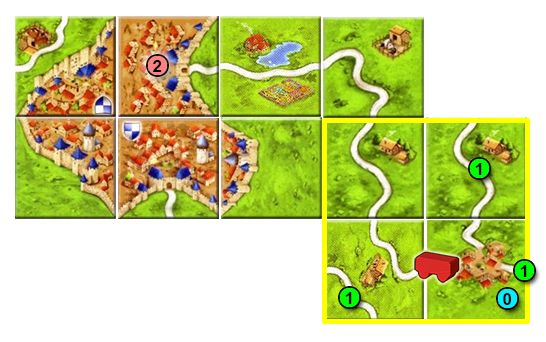
- 0 Tile just placed.
- 1 The wagon can move to any of these tiles within range because they belong to uncompleted unoccupied roads; two of them are connected to the same crossroads closing the road with the wagon and the other is on an orthogonal tile separated by a field.
- 2 The wagon cannot move to this uncompleted unoccupied city closing the road just completed because it is out of range.
Poznámky pod čarou
Vysvětlení ikonek najdete na této stránce.
- ↑
 Tyto příklady jsou založeny na vysvětleních, která poskytl Kettlefish v následujících příspěvcích na Carcassonne-Forum, a rozšiřují první příklad na obě edice o další případy (opatství a krátké cesty):
Tyto příklady jsou založeny na vysvětleních, která poskytl Kettlefish v následujících příspěvcích na Carcassonne-Forum, a rozšiřují první příklad na obě edice o další případy (opatství a krátké cesty):
- Příklady původního vydání: https://www.carcassonne-forum.de/viewtopic.php?f=292&t=3662#p46509
- Příklady nového vydání: https://www.carcassonne-forum.de/viewtopic.php?f=292&t=3662#p46513
